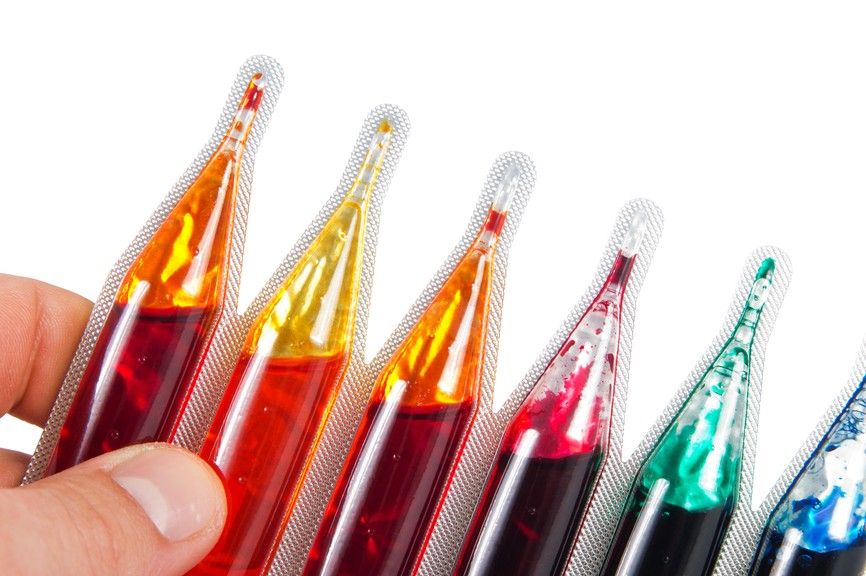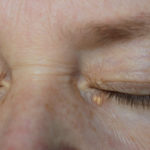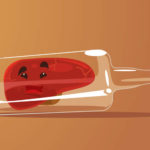
Previous
Top Liver Supplements: UltraThistle® vs. Clinical LiverSupport

Next
The Catch-22 of Chronic Liver Disease
Impact of Food Color on the Liver
Don’t depend on the FDA for your safety. Know which synthetic food dyes may be harmful to your liver.
Many of today’s food and beverages represent a striking color of the rainbow, raising their aesthetic appeal. Frequently, manufacturers resort to color additives to achieve the desired, appetizing hue. The U.S. Food and Drug Administration (FDA) is tasked with overseeing the safety and appropriate use of food color additives, but may fall short in protecting the long term wellness of those with a challenged liver.
A color additive is any dye, pigment or other substance that can impart color to a food, drug or cosmetic to the human body. Food color additives can be natural or synthetic. Despite the variety of natural options (beet juice, turmeric, hibiscus flower, chlorophyll, blueberry juice, red cabbage extract, etc.), 95 percent of the food dyes used today are synthetic because they are produced easily, cheaper and provide better and longer lasting coloration.
Synthetic color additives have been called coal-tar colors because of their traditional origins; today they are synthesized mainly from raw materials obtained from petroleum. All color additives listed by the FDA fall into two categories: those that are subject to batch certification process and those that are exempt. Color additives subject to batch certification are synthetic. Currently, the FDA has approved nine color additives for food that are subject to batch certification.
- FD&C Blue #1 – This coloring was banned in Austria, Belgium, Denmark, France, Germany, Greece, Italy, Norway, Spain, Sweden and Switzerland, but has since been let back into most of the countries under the European Union.
- FD&C Blue #2
- FD&C Green #3
- FD&C Red #3
- FD&C Red #40 – Banned in Denmark, Belgium, France, Germany, Switzerland, Sweden and Austria.
- FD&C Yellow #5 – Banned in Austria and Norway.
- FD&C Yellow #6
- Orange B
- Citrus Red #2
All nine of these synthetic food colorants are approved for use in the U.S., but two have specific restrictions: Orange B and Citrus Red #2. Orange B is restricted to the casings or surfaces of frankfurters and sausages and Citrus Red #2 is used to enhance the color of skins of oranges. The remaining seven colors all begin with the designation FD&C, indicating their safety for use in Food, Drugs and Cosmetics. With the FD&C prefix, it would be easy to assume these additives are innocuous. Unfortunately, this assumption is far from accurate.
In 2010, The Center for Science in the Public Interest (CSPI) published a comprehensive report called “Food Dyes: A Rainbow of Risks,” which addresses the risks of each of the nine synthetic food colors. Although the report doesn’t focus on the liver, it reveals that common food dyes pose tangible risks for cancer, hyperactivity in children, neurotoxicity and allergies. Each of the food color additives carries is own set of health warnings, but three involve liver-related risks.
- Citrus Red #2 – In one study from 1966 quoted by this CSPI report, mice fed Citrus Red #2 experienced increased mortality and females showed degeneration of the liver after a relatively short period of time. Today, this additive is only sanctioned to increase the color of orange peels. However, orange zest is a commonly consumed ingredient that comes from the rind. Although occasional ingestion of orange peel by a healthy person is unlikely to drastically impact the liver’s health, regular consumption in someone with chronic liver disease could contribute to further decline of his or her liver’s health. For those who might be using an orange for its zest, choosing an organic variety (the USDA organic certification process does not allow food dyes) will offer those with liver concerns protection against this additive. Another alternative is to buy California or Arizona citrus because these states prohibit the use of Citrus Red #2.
- FD&C Green #3 – In a 1977 study quoted by the CSPI report, FD&C Green #3 at high dosages yielded several pathological changes in animals. One of those changes includes an increased risk of developing liver neoplastic nodules. Neoplastic nodules in the liver represent abnormal tissue growth, a likely predecessor of cancerous tumors. Green #3 is not a common food dye, but it is occasionally used in blue-green colored candy and sports drinks. Before choosing a sweet treat with a glaringly unnatural aquamarine hue, consider switching to ice cream made from whole food ingredients or better yet – opt for a fresh fruit smoothie.
- FD&C Yellow #6 – Casually known as Sunset Yellow, FD&C Yellow #6 was also discussed in the CSPI report. A 1981 study by the National Toxicity Program found that low doses of FD&C Yellow #6 was associated with a significantly higher incidence of liver cancer in male mice compared to controls. Sunset Yellow is a common colorant and is found in many processed foods such as Orange Crush, Doritos and M&Ms. To protect your liver from the potential implications of Sunset Yellow, health experts suggest the following types of swaps: replace Orange Crush with seltzer water containing a squeeze from an organic orange; replace Doritos with freshly popped organic popcorn; and replace M&Ms with a square of dark chocolate. Yellow foods that do not contain one of the synthetic yellows may be colored naturally with turmeric or golden paprika extract.
In addition to the CSPI report, a relatively recent study published in the January-April 2014 edition of the journal Toxicology International warns those with liver concerns against consuming products with food dye blends. In this relatively recent study, Indian researchers evaluated the toxic effect of blending some food colors on animal subjects. They found that a blend of FD&C Yellow #6, FD&C Yellow #5 and Metanil yellow (a coloring used widely in Indian sweets) showed additive, negative effects on liver health. This phenomenon is frequently seen in human physiology, where the sum of a chemical’s effects is greater than its parts. These researchers determined that the addition of these three dyes together in food may give rise to more toxic effects than are produced by each dye individually.
Even though the U.S. has permitted food companies to use synthetic food coloring, it does not mean that these chemicals are safe. Especially when consumed in large quantities, in combinations or by someone who has a chronic illness, food dyes can be harmful. As such, avoiding fake, vibrantly colored food and drink is a smart health decision. For those who have liver health concerns, making sure you don’t consume Citrus Red #2, FD&C Green #3 and FD&C Yellow #6 is one more way to protect the liver from unnecessary risk.
http://foodconstrued.com/2013/01/sunset-yellow-fcf/, Sunset Yellow FCF, Retrieved January 15, 2015, Food Construed, 2015.
http://littlelocavores.blogspot.com/2011/02/when-orange-isnt-orange-food-dyes-in.html, When an Orange Isn’t Orange: Food Dyes in Fruit, Retrieved January 18, 2015, Little Locavores, 2015.
http://www.colourlovers.com/blog/2007/09/19/the-7-wonders-of-the-food-coloring-world, The 7 Wonders of the Food Coloring World, Retrieved January 18, 2015, Creative Market Labs, Inc, 2015.
http://www.fda.gov/ForIndustry/ColorAdditives/RegulatoryProcessHistoricalPerspectives/, Color Additives: FDA's Regulatory Process and Historical Perspectives, JN Barrows, PhD, et al, Retrieved January 15, 2015, Food Safety Magazine, October/November 2003.
http://www.fda.gov/ForIndustry/ColorAdditives/ColorAdditiveInventories/ucm115641.htm, Summary of Color Additives for Use in the United States in Foods, Drugs, Cosmetics, and Medical Devices, Retrieved January 15, 2015, US Food and Drug Administration, 2015.
http://www.foodsafetynews.com/2010/07/popular-food-dyes-linked-to-cancer-adhd-and-allergies/#.VLgUxlq4l-U, Food Dyes Linked to Cancer, ADHD, Allergies, Laurel Curran, Retrieved January 15, 2015, Marler Clark, 2015.
http://www.ncbi.nlm.nih.gov/pmc/articles/PMC3989917/, Serological Changes Induced by Blend of Sunset Yellow, Metanil Yellow and Tartrazine in Swiss Albino Rat, Rattus Norvegicus, B. Saxena, S. Sharma, Retrieved January 14, 2015, Toxicology International, January-April 2014.
http://www.thehealthsite.com/diseases-conditions/why-artificial-food-colours-are-bad-for-your-health-po0115/, Poorva Chavan, Retrieved January 14, 2015, TheHealthSite, 2015.










